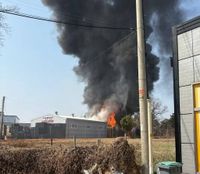A fire broke out at a factory in Hwaseong, South Korea, on March 22, 2025, prompting authorities to activate a stage 2 response protocol. This significant incident raises concerns about safety regulations in industrial environments.
The blaze, which erupted in the early morning, saw local firefighters swiftly mobilized to combat the flames. Eyewitnesses described thick smoke billowing from the building, visible from several blocks away. Emergency services worked diligently to contain the fire, fearing that it could escalate and affect nearby structures.
The rapid response from local fire departments was commendable. They quickly deployed multiple fire engines and personnel to the scene. According to one witness, who asked to remain anonymous, "The fire spread quickly; we were all horrified by how fast it engulfed the factory." This situation underscores the potential dangers inherent in such facilities, where flammable materials might be present.
Authorities are currently investigating the cause of the fire. Industrial accidents are common in places where oversight might be lax. In recent years, there have been calls for stricter regulations to ensure the safety of workers and nearby residents. However, implementing these changes has often been met with resistance from factory owners, who cite financial constraints.
The incident in Hwaseong is a stark reminder of these ongoing safety debates. Local residents have raised alarms about the need for better safety measures. Many believe that more rigorous inspections and regulations may have helped prevent this disaster.
Meanwhile, the local government pledged to increase scrutiny on industrial facilities to guarantee compliance with safety standards. A representative stated, "We will not take this incident lightly; investigations will be thorough, and we will ensure that measures are taken to prevent recurrences. Safety is our top priority." This statement reflects a growing concern among community members who fear for their safety in proximity to such hazardous operations.
As emergency teams continue to manage the situation, the community is left to grapple with the implications of this fire. Families who live nearby are understandably shaken, and people are wary about the future of industrial enterprises in their area. Many are wondering how this will affect local employment, as shutdowns may be necessary during investigations and repairs.
The fire in Hwaseong may serve as a pivotal point for both community action and policy change. With increasing public awareness of industrial safety, there is hope that meaningful reforms will be pushed forward, transforming the landscape of local industry.
In the weeks to come, local authorities will be under pressure to respond not only to the current crisis but also to the persistent demand for improved safety standards across all industrial sectors. The outcome of ongoing investigations will likely influence public sentiment and legislative priorities going forward.
This incident emphasizes the importance of vigilance in industrial safety and the dire consequences that can result without appropriate oversight. As the community recovers, voices calling for reform and enhanced protection for workers and residents will become increasingly difficult to ignore.
Ultimately, how this incident unfolds will be closely monitored, with many looking to the government and regulatory bodies to take decisive action that prioritizes both safety and community well-being.




